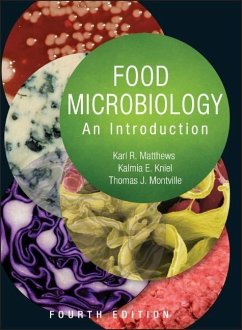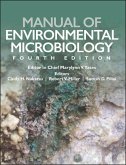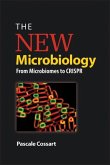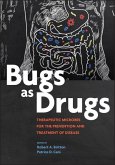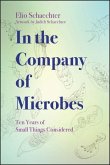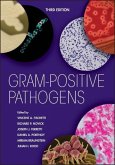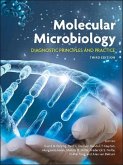- Gebundenes Buch
- Merkliste
- Auf die Merkliste
- Bewerten Bewerten
- Teilen
- Produkt teilen
- Produkterinnerung
- Produkterinnerung
Food Microbiology clarifies complex topics in the field of food microbiology and encourages students to venture beyond memorization and think critically to gain a broader conceptual understanding of food microbiology and acquire the understanding and skills necessary to ensure the safety of tomorrow's food supply.
Andere Kunden interessierten sich auch für
![Manual of Environmental Microbiology Manual of Environmental Microbiology]() Manual of Environmental Microbiology218,99 €
Manual of Environmental Microbiology218,99 €![The New Microbiology The New Microbiology]() Pascale CossartThe New Microbiology35,99 €
Pascale CossartThe New Microbiology35,99 €![Bugs as Drugs Bugs as Drugs]() Bugs as Drugs135,99 €
Bugs as Drugs135,99 €![In the Company of Microbes In the Company of Microbes]() Moselio SchaechterIn the Company of Microbes23,99 €
Moselio SchaechterIn the Company of Microbes23,99 €![One Health One Health]() One Health100,99 €
One Health100,99 €![Gram-Positive Pathogens Gram-Positive Pathogens]() Gram-Positive Pathogens203,99 €
Gram-Positive Pathogens203,99 €![Molecular Microbiology Molecular Microbiology]() Molecular Microbiology220,99 €
Molecular Microbiology220,99 €-
-
-
Food Microbiology clarifies complex topics in the field of food microbiology and encourages students to venture beyond memorization and think critically to gain a broader conceptual understanding of food microbiology and acquire the understanding and skills necessary to ensure the safety of tomorrow's food supply.
Hinweis: Dieser Artikel kann nur an eine deutsche Lieferadresse ausgeliefert werden.
Hinweis: Dieser Artikel kann nur an eine deutsche Lieferadresse ausgeliefert werden.
Produktdetails
- Produktdetails
- ASM
- Verlag: Wiley / Wiley & Sons
- Artikelnr. des Verlages: 1W555819380
- 4. Aufl.
- Seitenzahl: 624
- Erscheinungstermin: 1. März 2017
- Englisch
- Abmessung: 284mm x 223mm x 35mm
- Gewicht: 1900g
- ISBN-13: 9781555819385
- ISBN-10: 1555819389
- Artikelnr.: 45604187
- Herstellerkennzeichnung
- Libri GmbH
- Europaallee 1
- 36244 Bad Hersfeld
- 06621 890
- ASM
- Verlag: Wiley / Wiley & Sons
- Artikelnr. des Verlages: 1W555819380
- 4. Aufl.
- Seitenzahl: 624
- Erscheinungstermin: 1. März 2017
- Englisch
- Abmessung: 284mm x 223mm x 35mm
- Gewicht: 1900g
- ISBN-13: 9781555819385
- ISBN-10: 1555819389
- Artikelnr.: 45604187
- Herstellerkennzeichnung
- Libri GmbH
- Europaallee 1
- 36244 Bad Hersfeld
- 06621 890
Karl R. Matthews is a professor of microbial food safety at Rutgers University. He received a PhD from the University of Kentucky in 1988. Dr. Matthews has earned an international reputation for his work on the interaction of foodborne pathogens with fresh fruits and vegetables. This includes demonstrating the internal localization of bacteria during growth of leafy greens. He further showed that the internalization process is a passive event by demonstrating the internalization of fluorescent polystyrene beads. Dr. Matthews has also been active in research on antimicrobial resistance of foodborne bacteria and development of novel antimicrobial agents. Kalmia E. Kniel is a professor of microbial food safety in the Department of Animal and Food Sciences at the University of Delaware She received her PhD from Virginia Tech in Food Science and Technology in 2002. Her doctoral work focused on protozoan parasites. After that, she was a postdoctoral microbiologist at the USDA Agricultural Research Service's Animal Parasitic Diseases Laboratory. She is nationally recognized as a leading expert in transmission of viruses, protozoa, and bacteria in the preharvest environment. Dr. Kniel has been active in researching the mechanisms behind the survival and inactivation of norovirus, hepatitis A virus, and other enteric viruses in our water and foods. She is an active advocate for teaching food safety at all levels and has been involved with elementary and secondary education. At the University of Delaware, she teaches courses on foodborne outbreak investigations and the basics of food science and food safety from farm to fork. Thomas J. Montville is a distinguished professor emeritus at Rutgers University, where he received his BS in 1975. Dr. Montville received his PhD from the Massachusetts Institute of Technology (MIT) and then worked at the U.S. Department of Agriculture (USDA) as a research microbiologist before returning to Rutgers as a professor. He has published over 100 research papers on Clostridium botulinum, Listeria monocytogenes, antimicrobial peptides, and Bacillus anthracis. Dr. Montville is a fellow of the American Academy of Microbiology and a fellow of the Institute of Food Technologists.
Chapter 1 The Trajectory of Food Microbiology
Chapter 2 Microbial Growth, Survival, and Death in Foods
Chapter 3 Spores and Their Significance
Chapter 4 Detection and Enumeration of Microbes in Food
Chapter 5 Rapid and Automated Microbial Methods
Chapter 6 Indicator Microorganisms and Microbiological Criteria
Chapter 7 Regulatory Issues
Chapter 8 Bacillus cereus
Chapter 9 Campylobacter Species
Chapter 10 Clostridium botulinum
Chapter 11 Clostridium perfringens
Chapter 12 Enterohemorrhagic Escherichia coli
Chapter 13 Listeria monoctyogenes
Chapter 14 Salmonella Species
Chapter 15 Shigella Species
Chapter 16 Staphylococcus aureus
Chapter 17 Vibrio Species
Chapter 18 Yersinia enterocolitica
Chapter 19 Lactic Acid Bacteria and Their Fermentation Products
Chapter 20 Yeast-Based and Other Fermentations
Chapter 21 Spoilage Organisms
Chapter 22 Molds
Chapter 23 Parasites
Chapter 24 Viruses and Prions
Chapter 25 Chemical Antimicrobials
Chapter 26 Biologically Based Preservation and Probiotic Bacteria
Chapter 27 Physical Methods of Food Preservation
Chapter 28 Nonthermal Processing
Chapter 29 Sanitation and Related Practices
Critical Thinking Skills
Useful Websites for Food Safety Information
Glossary
Answers to Crossword Puzzles
Answers to Selected Questions for Critical Thought
Index
Chapter 2 Microbial Growth, Survival, and Death in Foods
Chapter 3 Spores and Their Significance
Chapter 4 Detection and Enumeration of Microbes in Food
Chapter 5 Rapid and Automated Microbial Methods
Chapter 6 Indicator Microorganisms and Microbiological Criteria
Chapter 7 Regulatory Issues
Chapter 8 Bacillus cereus
Chapter 9 Campylobacter Species
Chapter 10 Clostridium botulinum
Chapter 11 Clostridium perfringens
Chapter 12 Enterohemorrhagic Escherichia coli
Chapter 13 Listeria monoctyogenes
Chapter 14 Salmonella Species
Chapter 15 Shigella Species
Chapter 16 Staphylococcus aureus
Chapter 17 Vibrio Species
Chapter 18 Yersinia enterocolitica
Chapter 19 Lactic Acid Bacteria and Their Fermentation Products
Chapter 20 Yeast-Based and Other Fermentations
Chapter 21 Spoilage Organisms
Chapter 22 Molds
Chapter 23 Parasites
Chapter 24 Viruses and Prions
Chapter 25 Chemical Antimicrobials
Chapter 26 Biologically Based Preservation and Probiotic Bacteria
Chapter 27 Physical Methods of Food Preservation
Chapter 28 Nonthermal Processing
Chapter 29 Sanitation and Related Practices
Critical Thinking Skills
Useful Websites for Food Safety Information
Glossary
Answers to Crossword Puzzles
Answers to Selected Questions for Critical Thought
Index
Chapter 1 The Trajectory of Food Microbiology
Chapter 2 Microbial Growth, Survival, and Death in Foods
Chapter 3 Spores and Their Significance
Chapter 4 Detection and Enumeration of Microbes in Food
Chapter 5 Rapid and Automated Microbial Methods
Chapter 6 Indicator Microorganisms and Microbiological Criteria
Chapter 7 Regulatory Issues
Chapter 8 Bacillus cereus
Chapter 9 Campylobacter Species
Chapter 10 Clostridium botulinum
Chapter 11 Clostridium perfringens
Chapter 12 Enterohemorrhagic Escherichia coli
Chapter 13 Listeria monoctyogenes
Chapter 14 Salmonella Species
Chapter 15 Shigella Species
Chapter 16 Staphylococcus aureus
Chapter 17 Vibrio Species
Chapter 18 Yersinia enterocolitica
Chapter 19 Lactic Acid Bacteria and Their Fermentation Products
Chapter 20 Yeast-Based and Other Fermentations
Chapter 21 Spoilage Organisms
Chapter 22 Molds
Chapter 23 Parasites
Chapter 24 Viruses and Prions
Chapter 25 Chemical Antimicrobials
Chapter 26 Biologically Based Preservation and Probiotic Bacteria
Chapter 27 Physical Methods of Food Preservation
Chapter 28 Nonthermal Processing
Chapter 29 Sanitation and Related Practices
Critical Thinking Skills
Useful Websites for Food Safety Information
Glossary
Answers to Crossword Puzzles
Answers to Selected Questions for Critical Thought
Index
Chapter 2 Microbial Growth, Survival, and Death in Foods
Chapter 3 Spores and Their Significance
Chapter 4 Detection and Enumeration of Microbes in Food
Chapter 5 Rapid and Automated Microbial Methods
Chapter 6 Indicator Microorganisms and Microbiological Criteria
Chapter 7 Regulatory Issues
Chapter 8 Bacillus cereus
Chapter 9 Campylobacter Species
Chapter 10 Clostridium botulinum
Chapter 11 Clostridium perfringens
Chapter 12 Enterohemorrhagic Escherichia coli
Chapter 13 Listeria monoctyogenes
Chapter 14 Salmonella Species
Chapter 15 Shigella Species
Chapter 16 Staphylococcus aureus
Chapter 17 Vibrio Species
Chapter 18 Yersinia enterocolitica
Chapter 19 Lactic Acid Bacteria and Their Fermentation Products
Chapter 20 Yeast-Based and Other Fermentations
Chapter 21 Spoilage Organisms
Chapter 22 Molds
Chapter 23 Parasites
Chapter 24 Viruses and Prions
Chapter 25 Chemical Antimicrobials
Chapter 26 Biologically Based Preservation and Probiotic Bacteria
Chapter 27 Physical Methods of Food Preservation
Chapter 28 Nonthermal Processing
Chapter 29 Sanitation and Related Practices
Critical Thinking Skills
Useful Websites for Food Safety Information
Glossary
Answers to Crossword Puzzles
Answers to Selected Questions for Critical Thought
Index

